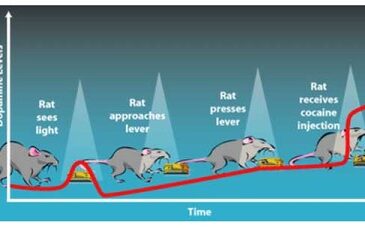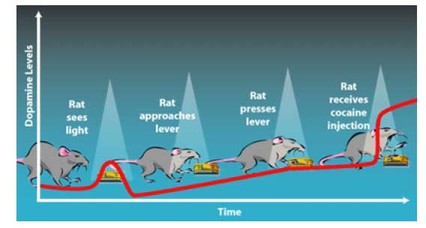The neurotransmitter dopamine is a key player in the brain’s reward pathway. When the brain recognizes a rewarding behavior, it releases dopamine (Spanagel & Weiss, 1999). In the past, researchers have only been able to measure the presence of dopamine on a minute-to-minute scale. Researchers have not been able to detect and measure quick pulses of neurotransmitters that might be responsible for activating or blocking pathways. Recent technical advances now allow sub-second measurements of dopamine levels in the brain. Phillips et al. (2003) employed this new technology to more precisely detect brief pulses of dopamine in rats seeking cocaine. As the WAGER reports below, their findings suggest a new role for dopamine in the development of addictive behavior patterns.
Six rats were trained to press a lever for intravenous infusion of cocaine: the lever press resulted in a 20 second audiovisual stimulus (a continuous tone and light) prior to the release of cocaine. This audiovisual stimulus created a learned cue that the rats associated with impending cocaine administration, similar to a cocaine user recognizing drug paraphernalia. The rats then underwent surgery to implant a carbon-fibre microelectrode to measure dopamine levels in the brain and which could be used to electrically stimulate dopamine production. After a week of recovery, the rats were exposed to the audiovisual cue in absence of the lever press. Phillips et al. used electrochemical technology to measure dopamine every 100 milliseconds in the nucleus accumbens region of the rats’ brains.
Phillips et al. (2003) found that the audiovisual cue itself elicited a brief pulse of dopamine lasting only a few seconds: a duration that previously could not be measured. This dopamine pulse initiated a pattern of drug-seeking behaviors (i.e., approaching and pressing the lever) in the rats, during which time dopamine levels continued to climb slowly. The dopamine levels peaked when the rats self-administered cocaine by pressing the lever (see Figure 1). Researchers were able to reproduce the drug seeking behaviors by electrically stimulating the release of dopamine in the rats’ brains. This confirmed that the observed drug-seeking behaviors were a direct result of dopamine release and not due to another neurological change stimulated by the same audiovisual cue.
Figure 1. Dopamine levels and behavioral pattern resulting from a learned audiovisual cue (Figure taken from Self, 2003)
This research indicates that dopamine production occurs not only in response to rewarding behaviors (i.e. drug use or gambling), but also can trigger these behaviors after an initial rewarding experience with the drug or activity. In the laboratory, a dopamine pulse was stimulated by external cues that the rats had learned to associate with cocaine administration or by experimenter electronic stimulation. Both triggered drug-seeking behaviors. In a gambling context, pathological gamblers might experience this pulse of dopamine when they observe objects they associate with rewarding behaviors, such as casino chips or the smell of race horses. Pathological gamblers might then experience a craving to engage in these activities and begin searching for a gambling opportunity.
Cravings play a large role in the development and maintenance of addictive behaviors; however, little is known about their physiological origins. This study suggests that dopamine might play a critical role in the regulation of cravings and the subsequent behavioral response (i.e., drug use or gambling participation) to these cravings. A better understanding of dopamine’s function might lead to treatments that block this signal and thus interrupt the enforcing cycle of gambling addiction.
Comments on this article can be addressed to Rachel Kidman at wager@hms.harvard.edu.
References
Phillips, P., Stuber, G., Heien, M., Wightman, R., & Carelli, R. (2003). Subsecond dopamine release promotes cocaine seeking. Nature, 422, 614-618.
Self, D. (2003). Dopamine as chicken and egg. Nature, 422, 573-574.
Spanagel, R., & Weiss, F. (1999). The dopamine hypothesis of reward: past and current status. Trends in Neuroscience, 22(11), 521-527.
The WAGER is a public education project of the Division on Addictions at Harvard Medical School. It is funded, in part, by the National Center for Responsible Gaming, the Massachusetts Department of Public Health, the Substance Abuse and Mental Health Services Administration, and the Center for Substance Abuse Treatment.





